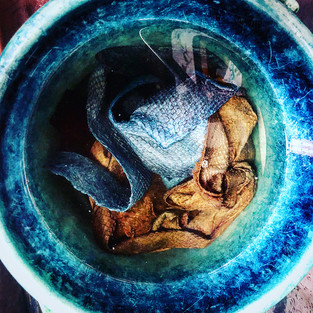Participants:
University of Arts London - Elisa Palomino
The report addresses the objective of innovating (traditional) creative and cultural industries and empowering cross-sectoral collaboration. The report, initiated by the Northern Dimension Partnership on Culture Strategy (NDPC) describes our project:
"FISHSkin (2019–2023) is a project that aims to increase the market take-up of fish leather to an industrial scale. It seeks to do this by integrating knowledge from different disciplines, Fashion Design, Material Science and Marine Biology, to form a new collective knowledge through which academic and industrial experts will strive to develop new techniques and methodologies."
Link to the Report
Link to FISHSkin contribution by our researcher Elisa Palomino of UAL. Pages 27, 34
Participants:
Kyoto Seika University - Mitsuhiro Kokita and Yuji Yonehara University of Arts London - Elisa Palomino
Researchers Mitsuhiro Kokita and Yuji Yonehara of FISHSkin’s partner Kyoto Seika University were interviewed by the Japanese newspaper Yomiuri Shimbun last September. Titled "Salmon Skin Transformed into Fish Leather" the article described Kyoto Seika's challenges in dyeing fish leather and the hope to expand the demand and clientele for the Kyoto traditional textile dyeing industry. The article also references traditional usage of fish skin in Ainu shoes, bags and ritual garments, and fish leather items created by the Italian fashion house Salvatore Ferragamo during the 1930s and 40s. Pictured on the right are fish leather handbags by our project's researcher, Elisa Palomino.
Location: Hokkaido, Japan
The use of fish skin for the construction of garments is an ancient tradition shared by Arctic coastal societies, some of the earliest traces being found from the Ainu populations in Hokkaido, Japan.
The FISHSkin project has developed common interests in the UK and Japan around topics of fish skin, leather and sustainability. The project has brought together a community of experts including fashion design academics and practitioners, and artisan experts in natural dyes, with the aim of improving knowledge of sustainable methods for fish skin production as a greener alternative to exotic leather. The FISHSkin project has mapped existing traditional knowledge on natural dying from Japanese craftsmen in order to transfer the skills into fish skin.
During the trip Elisa Palomino worked with a traditional Japanese dyer at Tokushima and tested indigo dyeing on fish skin. The results were later tested on at Ars Tinctoria laboratory by Gustavo Defeo and Massimo Mancuso to evaluate the possible use in contemporary industrial dyeing for fish skin. The physical and rheological properties of the indigo and persimmon natural dye were measured for the evaluation of dye stability. The tests were found to be suitable. The samples were subjected to light and rub fastness tests and colour measurements. Colour consistency and fastness results, especially after fixation, are comparable with those on conventional leather. Fastness properties were analysed following updated ISO standards.
















